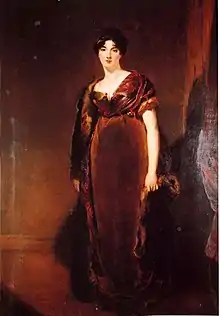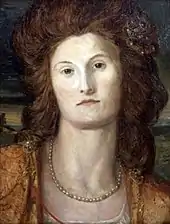The Lady Ashburton | |
|---|---|
.jpg.webp) Lady Ashburton | |
| Personal details | |
| Born | Louisa Caroline Stewart-Mackenzie 5 March 1827 Stornoway, Isle of Lewis, Scotland |
| Died | 2 February 1903 (aged 75) Knightsbridge, London, England |
| Spouse | |
| Relations | William Compton, 6th Marquess of Northampton (grandson) |
| Children | Mary Compton, Marchioness of Northampton |
| Parent(s) | Mary Mackenzie James Alexander Stewart-Mackenzie |
Louisa Caroline Baring, Lady Ashburton (née Stewart-Mackenzie; 5 March 1827 – 2 February 1903) was a Scottish art collector and philanthropist who had close connections with several artistic and literary figures of the period.
Early life

Louisa Caroline Stewart-Mackenzie was born on 5 March 1827 at Seaforth Lodge, Stornoway, on the Isle of Lewis, Scotland, the youngest daughter and sixth child of James Alexander Stewart-Mackenzie (1784–1843), a Scottish politician and British colonial administrator, and his wife Mary Elizabeth Frederica Mackenzie (1783–1862), known as "The Hooded Lassie".[1] Her name Louisa honoured the isle of her birth.[2] Her early childhood was spent at Brahan Castle near Dingwall, which her mother had inherited from the Seaforth family. In adolescence, she lived in Ceylon (now Sri Lanka), while her father was governor and then in 1841, the family moved to Corfu, Greece, when he became Lord High Commissioner of the Ionian Islands. Upon his death in 1843 the family returned to Brahan Castle, where Louisa lived until her marriage.[3]
Of fiery temper, insatiable restlessness, and socially ambitious, she collected paintings and important friends with an almost manic need. In her youth, Louisa studied drawing with John Ruskin, who saw her as a romantic young girl, with a desperate desire to marry.[1] Among her notable friends were Robert Browning, to whom she at one time unsuccessfully proposed marriage,[1][2] Thomas Carlyle, Edwin Landseer, whose attentions she rejected,[4] Florence Nightingale and Pauline, Lady Trevelyan.[1]
_J.W.C._At_the_Grange_abt._1865.jpg.webp)
Art collection
Lady Ashburton was known for amassing a large collection of art works and distributing them among her residences at Seaforth Lodge, Melchet Court in Hampshire, and Kent House in Knightsbridge, London. Though no inventory existed, among the known works were sketches, watercolors and sculptures by Rubens, Mantegna, Rossetti, W. L. Leitch, Harriet Hosmer, Edward Lear, G. F. Watts, Marochetti and Titian.[1] When she tired of collecting, Lady Ashburton became an advocate for temperance and a benefactor to several noted charities, including the Ashburton Home of Rest and the Canning Town Mission to Seamen, as well as several clean water initiatives and charitable societies affiliated with religious organizations.[1] The collection was bought by a syndicate of London art dealers in 1907 to be further sold.[5]
Personal life

On 17 November 1858 Louisa married the widowed Bingham Baring, 2nd Baron Ashburton (1799–1864),[1][6] a member of the Baring family of merchants and bankers. His first wife, Lady Harriet Mary Montagu (eldest daughter of George Montagu, 6th Earl of Sandwich), had died the previous year.[7] Lord Ashburton and Louisa were the parents of Mary Florence Baring (1860–1902),[8] who was named after Florence Nightingale,[9] who was a close friend of Louisa.[4] Mary married William Compton, 5th Marquess of Northampton, in 1884, becoming the Marchioness of Northampton.[10][11]
After a year of ill health, Lord Ashburton died in 1864.[1] Lady Ashburton subsequently had an intimate relationship with the American sculptor Harriet Hosmer,[12][13] whose studio she first came to in the spring of 1867.[12] Hosmer recalled being immediately smitten by Lady Ashburton's "statuesque beauty" and compared her to a goddess, writing, "There was the same square-cut and grandiose features, whose classic beauty was humanized by a pair of keen dark eyes."[14] Lady Ashburton ordered several pieces of Hosmer's work and soon became a patron.[15][16] The relationship changed from friendship to romance in the spring of 1868 when the two took a trip to Perugia, Italy.[17]
The apparent exclusivity Harriet longed for was threatened by several relationships Louisa had, notably by an approximately three-year involvement with the poet Robert Browning, and by a complicated relationship she had with her daughter's tutor, Margaret Trotter.[18][19] And no matter how much Harriet liked to consider herself Louisa's "hubby",[20] she, too, had occasional extra-relational involvements.[21]
Philanthropy
In later life, Lady Ashburton funded a number of buildings with a Christian or social welfare function, including in 1899 Landford Wood Mission Hall, in the village of Landford on the edge of her Melchet Court estate.[22]
Death and legacy
Lady Ashburton died of breast cancer on 2 February 1903, aged 75, at Kent House, Rutland Gardens, Knightsbridge, London.[23] She is buried at Kinlochluichart Church, Garve, Highland, Scotland.[1]
Her papers, along with those of other members of the Ashburton family have been deposited at the National Library of Scotland. Due to her extensive correspondence with other notable figures, the archive is an important historic collection.[24]
References
Citations
- 1 2 3 4 5 6 7 8 9 Surtees, Virginia (2004). "Baring [née Stewart-Mackenzie], Louisa Caroline, Lady Ashburton (1827–1903)". Oxford Dictionary of National Biography (online ed.). Oxford University Press. doi:10.1093/ref:odnb/50780. Retrieved 20 July 2017. (Subscription or UK public library membership required.)
- 1 2 Clifford, Edward (7 February 1903). "The Late Lady Ashburton". The Spectator. London, England. p. 15. Archived from the original on 20 July 2017. Retrieved 20 July 2017.
- ↑ "Baring [née Stewart-Mackenzie], Louisa Caroline, Lady Ashburton (1827–1903), art collector and philanthropist". Oxford Dictionary of National Biography (online ed.). Oxford University Press. 2004. doi:10.1093/ref:odnb/50780. Retrieved 3 June 2020. (Subscription or UK public library membership required.)
- 1 2 Fielding, Kenneth J. (2004). "Ashburton, Louisa Lady". In Cumming, Mark (ed.). The Carlyle Encyclopedia. Fairleigh Dickinson Univ Press. pp. 22–23. ISBN 978-0-8386-3792-0.
- ↑ "ART TREASURES SOLD.; Famous Ashburton Collection About to be Dispersed, It Is Said". The New York Times. 16 October 1907. Retrieved 3 June 2020.
- ↑ Reynolds, K. D. (2004). "Baring [née Montagu], Harriet Mary, Lady Ashburton (1805–1857)". Oxford Dictionary of National Biography (online ed.). Oxford University Press. doi:10.1093/ref:odnb/1384. Retrieved 20 July 2017. (Subscription or UK public library membership required.)
- ↑ "Harriet, Lady Ashburton". The New York Times. 6 July 1873. Retrieved 3 June 2020.
- ↑ Cumming, Mark (2004). The Carlyle Encyclopedia. Fairleigh Dickinson Univ Press. p. 22. ISBN 978-0-8386-3792-0. Retrieved 3 June 2020.
- ↑ Sherwood 1991, p. 266.
- ↑ McDonald 2006, p. 710.
- ↑ "Obituary". The Times. London, England. 3 June 1902. p. 10. Retrieved 20 July 2017 – via Newspapers.com.
- 1 2 Vicinus 2004, p. 49.
- ↑ Culkin 2010, pp. 102–103, 270–273.
- ↑ Sherwood 1991, p. 265.
- ↑ Culkin 2010, p. 117.
- ↑ Vicinus 2004, pp. 50, 53–54.
- ↑ Culkin 2010, p. 118.
- ↑ Culkin 2010, pp. 118–119.
- ↑ Vicinus 2004, pp. 54.
- ↑ Fryd 2006, p. 306.
- ↑ Culkin 2010, p. 119.
- ↑ Gibson, Gemma (17 November 2020). "Hall with 'outstanding historic interest' granted protection with new status". Salisbury Journal. Retrieved 22 November 2020.
- ↑ Greenacombe, John. "Survey of London: Volume 45, Knightsbridge. Originally published by London County Council, London, 2000". British History Online. Retrieved 4 August 2020.
- ↑ "Inventory: Ashburton Papers" (PDF). National Library of Scotland. Edinburgh, Scotland. 1996. Acc.11388. Retrieved 20 July 2017.
Bibliography
- Surtees, Virginia (1984). The Ludovisi goddess : the life of Louisa Lady Ashburton. Salisbury, Wiltshire: M. Russell. ISBN 978-0859551052.
- Culkin, Kate (2010). Harriet Hosmer: A Cultural Biography. Amherst, Massachusetts: University of Massachusetts Press. ISBN 978-1-55849-839-6.
- Fryd, Vivien Green (June 2006). "The "Ghosting" of Incest and Female Relations in Harriet Hosmer's "Beatrice Cenci"". The Art Bulletin. New York, New York: College Art Association. 88 (2): 292–309. doi:10.1080/00043079.2006.10786291. ISSN 0004-3079. JSTOR 25067246. S2CID 190701517.
- McDonald, Lynn (2006). Florence Nightingale on Women, Medicine, Midwifery and Prostitution: Collected Works of Florence Nightingale. Waterloo, Ontario, Canada: Wilfrid Laurier University Press. ISBN 978-0-88920-916-9.
- Sherwood, Dolly (1991). Harriet Hosmer, American sculptor, 1830-1908. Columbia, Missouri: University of Missouri Press. ISBN 978-0-8262-0766-1.
- Vicinus, Martha (2004). Intimate Friends: Women Who Loved Women, 1778-1928. Chicago, Illinois: University of Chicago Press. ISBN 978-0-226-85563-9.